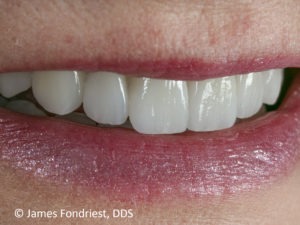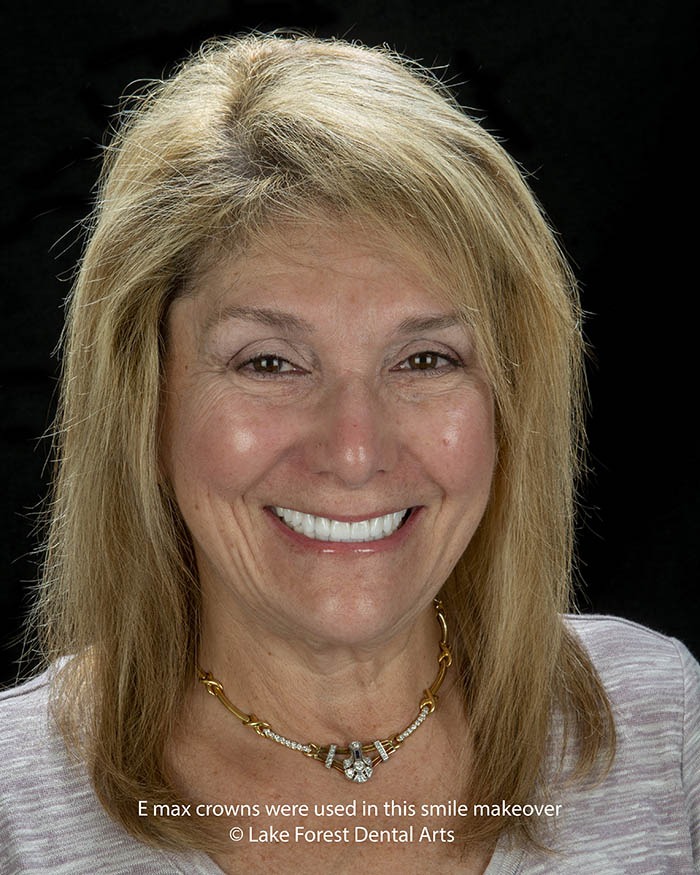
Do your porcelain crowns look like real teeth? Are they indistinguishable from nature? Not all crowns look alike, and not all dentists create a natural look. Our office proudly offers advanced E Max dental crowns.
A dental crown is named after the top part of your tooth, which it’s built to restore. Your tooth’s crown sits above the gum line, and is responsible for biting, chewing, and grinding food. A dental crown is a custom made replica of your tooth’s original shape. It is designed to cap the tooth and take over its responsibilities. To accommodate the crown, Dr. Fondriest will sculpt the tooth before bonding the restoration in place.
How E Max and other Ceramic Restorations Made
Your teeth are arranged in a specific pattern to evenly distribute biting pressure. When your dentist works on your occlusion, it is to evenly distribute these bite forces. Back teeth are designed to take the majority of the bite loads.
For this reason, crowns on back teeth are often reinforced with metal.
The metal will increase their strength.
For most other teeth, however, dental crowns are typically crafted from innovative dental porcelain. The translucent E Max material is tinted to match each patient’s specific tooth color. The porcelain is layered to mimic the way tooth enamel reflects light. We proudly offer our Chicago-area patients crowns made with many crown material options:

This smile makeover was done with E max crowns
E Max:
E Max (ips e.max cad) is a new cosmetic material that has become popular due its natural looking results. Emax is usually designed with two layers just as PFM crowns are. There is a durable supporting layer called the coping. A special natural looking layer is applied on top of the coping by a skilled artisan. This ceramist will match the restoration to the features of your natural teeth. For your visible teeth, E Max delivers incredibly lifelike results.
E Max is bio-compatible, meaning there is no risk for adverse allergic reactions with the material. The material also exhibits the same wear pattern as enamel. E Max crown restorations are 2.5 to 3 times stronger than other glass-ceramic systems due to increased flexural strength.
E Max Monolithic:
This crown uses only the coping layer found in E Max crowns. The lithium disilicate ceramic material still retains a natural looking shade and is more resistant to chipping. The cosmetic top layer of ceramic is often the weak link in porcelain restoration. E Max Monolithic is ideal for individuals who grind their teeth.
Zirconium:
Zirconia crowns are considered the strongest material for prosthetics. The ceramic used to make the crowns is made in one or two layers and offers unrivaled strength. Under the skilled hands of a master ceramist, zirconium can deliver strength and beauty. We create a restoration that friends, family, and coworkers would not recognize as artificial.
What Are E Max Dental Crowns For?
Cosmetic agendas
Because of their ability to closely mimic natural teeth, this type of crown is often used in a cosmetic role to create seamless dental restorations. A tooth that is severely stained or discolored, or misshapen can be reinvented. If the design is artfully done, E max crowns deliver especially natural looking results.
Restoring your tooth
The main purpose of a dental crown is usually to protect a tooth from certain doom. If the tooth is fractured, broken, or had a root canal, the damage will grow worse with time. The more the tooth is exposed to the pressures of biting and chewing, the risks increase. A cap or crown completely covers your tooth to prevent further damage. It also reduces the risk of a future tooth infection.
Prosthetic replacements
As prosthetic devices, dental crowns are often used to support a dental bridge to replace one or more lost teeth. Dental bridgework consists of an appropriate number of replacement teeth, with a dental crown on either side of the device. The crowns are bonded to the remaining healthy teeth that border the empty gap, called abutment teeth.
A Look at the Treatment
Prior to placing an E Max crown, tooth preparations must be done. After your natural tooth has been numbed using local anesthesia, your dentist will remove the outer natural structure of your tooth. You will then be given a temporary crown while your customized restoration is created at a dental laboratory. When completed, the dentist will ensure that it is a perfect fit. Then it is bonded onto the prepared tooth.
Aftercare
Ceramic crowns should be cared for as if they were natural teeth. Although your crown is made from a durable material, you should never use it to bite or tear objects. Maintaining proper oral hygiene can preserve the underlying bone and surrounding gum tissue. We also highly recommend twice-a-year dental visits. During your regular visits or cleanings, Dr. Fondriest will check the stability and strength of your emax crown. These meetings allow him to make adjustments or corrections before they turn into more serious problems.
Learn How You Can Get E Max Crowns that look like real teeth
Learn how to replace your old dentistry with life-like crowns? Aside from providing expert general and cosmetic dentistry services to our community, Dr. James Fondriest also holds highly-respected academic appointments at the Pankey Institute and the Spear Institute in Scottsdale, AZ. He is a former Adjunct Associate Professor in the Department of Prosthodontics at the University of Florida Dental School.
Dr. Fondriest combines his impressive array of experience with modern technology and caring, compassionate, and knowledgeable staff. We proudly serve the Chicago metropolitan area including the North Shore and Northwest suburbs. If you are looking for invisible restorations, schedule a consultation by calling us at 847-234-0517.
